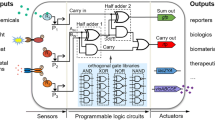Abstract
This paper describes a novel architecture inspired from the multicellular organizations found in Nature. This architecture is tailored to let functional organisms (logical functions) grow on silicon. To this aim, the silicon surface is populated with an array of identical programmable cells, which may be configured by a bitstream. By analogy with the biological world, the concatenation of the bitstreams used to program the cells composing a given function is called the “genome” of that function. In addition to conventional BIST (Built-in Self-Test) structures addressing signal line faults, this new version tolerates failures affecting power supply. It also allows the growth of differentiated organisms on the same surface by including a code in the genome to distinguish them. As a testbed, we have developped an integrated circuit prototype, code name GenomIC. It contains only a single 4-cell structure, but prefigures which kind of structure can be massively integrated in very large circuits in order to manage complexity (multicellular organization), evolvability (genetic data manipulation) as well as fault tolerance.
Preview
Unable to display preview. Download preview PDF.
Similar content being viewed by others
References
von Neumann J., The Theory of Self-Reproducing Automata, A.W. Burks, ed. Univ. Illinois Press, Urbana, (1966)
Codd E. F., Cellular Automata, Academic Press, New-York, (1968).
Langton C. G., Self-Reproduction in Cellular Automata, Physica 10D, 135–144, (1984)
Marchal P., Nussbaumm P., Piguet C., Durand S., Mange D., Sanchez E., Stauffer A., Tempesti G. Genomic Cellular Automata Transposed in Silicon, in IPCAT'95, World Scientific, 1996
Marchal P., Stauffer A. Binary Decision Diagram oriented FPGAs, ACM International Workshop on Field Programmable Gate Arrays, 2(1–10) (dy1994).
Marchal P., Piguet C., Mange D., Stauffer A. and Durand S. Embryological Development on Silicon, Proceeding of Artificial Life IV—MIT Press, 365–370 (1994).
Byl J., Self-Reproduction in Small Cellular Automata, Physica 34D, 295–299, (1989)
Reggia J. A., Armentrout S. L., Chou H. H., Peng Y., Science 259, 1282 (1993)
Marchal P., Embryonics: the Birth of Synthtic Life, in Towards Evolvable Hardware, Springer-Verlag, 1996
Mange D., Stauffer A., Marchal P., Embryonics: Designing Programmable Circuits with Biological-like Properties, 12th IASTED International Conference, Annecy, France, 1994
Author information
Authors and Affiliations
Editor information
Rights and permissions
Copyright information
© 1997 Springer-Verlag Berlin Heidelberg
About this paper
Cite this paper
Nussbaum, P., Marchal, P., Piguet, C. (1997). Functional organisms growing on silicon. In: Higuchi, T., Iwata, M., Liu, W. (eds) Evolvable Systems: From Biology to Hardware. ICES 1996. Lecture Notes in Computer Science, vol 1259. Springer, Berlin, Heidelberg. https://doi.org/10.1007/3-540-63173-9_43
Download citation
DOI: https://doi.org/10.1007/3-540-63173-9_43
Published:
Publisher Name: Springer, Berlin, Heidelberg
Print ISBN: 978-3-540-63173-6
Online ISBN: 978-3-540-69204-1
eBook Packages: Springer Book Archive




